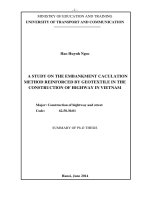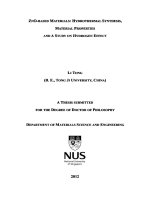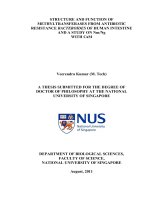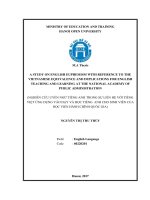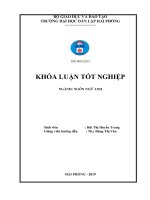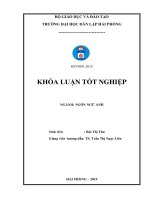Structure and function of methyltransferases from antibiotic resistance bacteroides of human intestine and a study on nm ng with cam
Bạn đang xem bản rút gọn của tài liệu. Xem và tải ngay bản đầy đủ của tài liệu tại đây (8.67 MB, 155 trang )
STRUCTURE AND FUNCTION OF
METHYLTRANSFERASES FROM ANTIBIOTIC
RESISTANCE BACTEROIDES OF HUMAN INTESTINE
AND A STUDY ON Nm/Ng
WITH CaM
Veerendra Kumar (M. Tech)
A THESIS SUBMITTED FOR THE DEGREE OF
DOCTOR OF PHILOSOPHY AT THE NATIONAL
UNIVERSITY OF SINGAPORE
DEPARTMENT OF BIOLOGICAL SCIENCES,
FACULTY OF SCIENCE,
NATIONAL UNIVERSITY OF SINGAPORE
August, 2011
ii
Acknowledgement
It would not have been possible to write this PhD thesis without the help and support
of the kind people around me, to only some of whom it is possible to give particular
mention here.
First of all, I wish to express my heartiest and sincere gratitude to my supervisor Prof
J. Sivaraman for his invaluable guidance, suggestions and constant encouragement to
do the research. Thanks for giving me the opportunity to work in your lab and
excellent training in X-ray crystallography. Your patience, constant support,
assistance and personal guidance have provided a good basis for the present thesis. I
have learned a lot from you, not only the science and research, but also care and love
that you share with student and others. Thank you for everything.
I wish to express my warm and sincere thanks to Professor Sheu Fwu-Shan who
introduced me in the research and gave opportunity to work in his lab for two years
which made the basis of this thesis. Thank you for offering me the scholarship in your
lab.
It is also a great pleasure for me to thank Prof K. Swaminathan for the constructive
and very informative discussion on crystallography. You offer me advice and
suggestions whenever I need which overcome various stumbling blocks in my
research. You always have been constant source of motivation and encouragement
during my study.
I also extend my deep and sincere thanks to all the lab members of SBL4, SBL5 and
other members of structure biology group for their kind help and creating friendly
atmosphere. In particular, I wish to thank to thanks Dr Tang Xuhua for her help in
teaching me to run different programmes. I thank Dr Jobi for all the scientific/
technical discussion. I thank Dr Mallika for her insightful comments, help and funny
iii
jokes. I also wish to thank Lissa for her kind help in getting the materials on time and
her kind help in conducting experiments. I extend my thanks to all my lab members
Priyanka, Thangavelu, Abhilash, Manjeet, Nilofer, Vivek, Umar and Pankaj for their
kind help through out my stay in lab. I also like to thank my wonderful new friend
Magendran for being so supportive and helpful.
Finally, I would like to acknowledge the financial, academic and technical support of
the Department of Biological Sciences and National University of Singapore for
awarding me the Postgraduate Research Scholarship.
iv
Table of contents
Page
Acknowledgements ii
Table of contents iv
Summary vii
List of tables x
List of Figures xi
List of abbreviations xv
Publications xviii
Part I-
Chapter 1: General Introduction
1
1.1 Introduction 2
1.1.1 Methyltransferase 2
1.1.2 Macromolecule versus small molecule methyltransferase 6
1.1.3 Functional Role of Methyltransferases 7
1.1.4 Antibiotic resistance and Methyltransferase 9
1.2 Bacteroides 10
1.3 Ubiquinone biosynthesis pathway 15
1.4 Aims and Objective 19
Chapter 2:
Purification, Crystallization and Diffraction studies of
Methyltransferases BT_2972 and BVU_3255 of Antibiotic Resistant
Pathogen Genus Bacteroides from the Human Intestine
20
2.1 Introduction 21
2.2 Materials and Methods 22
2.2.1 Cloning 22
2.2.2 Expression and purification 22
2.2.3 Dynamic light scattering 23
2.2.4 Crystallization 24
2.2.5 Data collection 24
2.3. Results 25
Chapter 3
A Conformational Switch in the Active Site of BT_2972, a MTase from
an Antibiotic Resistant Pathogen B. thetaiotaomicron Revealed by its
Structures
33
3.1 Introduction 34
3.2 Material and Methods 35
3.2.1 Cloning and protein purification 35
3.2.2 Crystallization and structure determination 35
3.2.3 Isothermal titration calorimetry 36
3.2.4 PDB deposition 37
v
3.3 Results 37
3.3.1 BT_2972 Sequence Analysis 37
3.3.2 Structure of BT_2972 and its AdoMet/AdoHcy complexes 39
3.3.3 Thermodynamics of AdoMet/AdoHcy binding 43
3.3.4 AdoMet/AdoHcy Binding Pocket of BT_2972 45
3.3.5 Conformational switch acts as a gate to the active site 45
3.3.6 Structural Comparison with other Homologs 47
3.3.7 Possible Substrate Binding Site and Substrate 50
3.4 Discussion 51
Chapter 4
Structural Characterization of BVU_3255, a Methyltransferase from
Human Intestine Antibiotic Resistant Pathogen Bacteroides vulgatus
56
4.1 Introduction 57
4.2 Materials and Methods 58
4.2.1 Cloning, expression and protein purification 58
4.2.2 Crystallization and structure determination 58
4.2.3 Isothermal titration calorimetry 59
4.2.4 PDB Code 59
4.3. Results and discussion 59
4.3.1 Overall structure 59
4.3.2 SAM and SAH binding site 63
4.3.3 Isothermal titration calorimetry 64
4.3.4 Sequence and structural homology 65
4.3.5 Inferred substrate binding site 68
Chapter 5
Conclusions and Future Directions
71
5.1 Conclusion 72
5.2 Future Directions 73
Part II
Chapter 6:
Interactions of the Intrinsically Disordered Neuron Specific Substrate
Proteins Neuromodulin (Nm) and Neurogranin (Ng) with Calmodulin
(CaM) Revealed by Biophysical and Structural Studies
74
6.1 Introduction 75
6.1.1 Neuron 75
6.1.2 Action Potentials 76
6.1.3 Communication between Synapses 77
6.1.4 Long term potentiation (LTP) 78
6.1.5 Long term depression (LTD) 78
6.2 Growth Associated Protein-43 (GAP-43, Nm) 79
6.3 Neurogranin (Ng) 84
6.4 Calmodulin (CaM) 88
6.4.1 CaM-binding proteins 90
vi
6.4.2 apo CaM-binding proteins 92
6.5 Objective of this study 93
6.6 Methods 94
6.6.1 Expression, purification and characterization of Nm
and Ng
94
6.6.2 Cloning, expression and purification of CaM constructs 95
6.6.3 Isothermal titration calorimetry 96
6.6.4 Crystallization and structure determination 97
6.6.5 Protein Data Bank accession code 99
6.7 Results 99
6.7.1 Nm and Ng are intrinsically unstructured proteins 99
6.7.1.1 Sequence analysis predicts Nm and Ng are intrinsically
unstructured proteins
99
6.7.1.2 Gel Filtration shows Nm and Ng exist in unfolded globular state 100
6.7.1.3 Residual Secondary structure from Far UV-CD 102
6.7.1.4 NMR spectroscopy suggests Nm and Ng are natively unfolded
proteins
104
6.7.2 Isothermal calorimetry 105
6.7.3 Nm/Ng CaM complex structural studies 110
6.7.3.1 Ca
2+
/CaM-NmIQ2 and Ca
2+
/CaM-NgIQ2 structures 110
6.7.3.2 apo CaM-(Gly)
5
-NmIQ2 and apo CaM-(Gly)
5
-NgIQ2 structures
114
6.7.3.2.1 apo CaM-(Gly)
5
-NmIQ2 114
6.7.3.2.2 apo CaM-(Gly)
5
-NgIQ2 119
6.8 Discussion 124
Chapter 7:
Conclusions and future directions
129
7.1 Conclusion 130
7.2 Future studies 131
Reference
132
vii
Summary
This thesis consists of two parts – Part I (Chapter 1-5): structural and functional
analysis of two methyltransferases from two different species of the genus
Bacteroides. Part II (Chapter 6-7) consist of the biophysical characterization of two
neuron specific protein kinase C (PKC) substrate proteins Neuromodulin (Nm) and
Neurogranin (Ng), and its structure of the IQ domain in complex with Calmodulin
(CaM).
Methylation is important for various cellular activities. More often methyltransferases
are involved in cellular and metabolic functions. To-date there is no report of any
methyltransferase structure from human intestine antibiotic resistance pathogenic
strains B. thetaiotaomicron VPI-5482 and B. vulgatus ATCC-8482. Chapter 1
provides general introduction for this part. Chapter 2 report the expression,
purification and crystallization of methyltransferases BT_2972 and BVU_3255 from
the species B. thetaiotaomicron VPI-5482 and B. vulgatus ATCC-8482 respectively.
These two MTases were cloned, over expressed and purified to yield approximately
120 mg of each protein from 1 L of the culture. Apo BT_2972 and BVU_3255 and
their complexes with AdoMet/AdoHcy were crystallized in four different crystal
forms using hanging drop vapour diffusion method. These crystals diffract to a
resolution ranging from 2.9 to 2.2 Å.
Chapter 3, report the crystal structure of an AdoMet dependent methyltransferase
BT_2972 and its complex with AdoMet and AdoHcy from B. thetaiotaomicron VPI-
5482 strain along with their isothermal titration calorimetric studies. The active site
of apo BT_2972 and structures of its complex with AdoMet and AdoHcy revealed
significant conformational changes which resulted in open and closed forms to
regulate the movement of cofactors and to aid its interaction with the substrate.
viii
Based on our analysis, supported with literature, we suggest that BT_2972 is a small
molecule methyltransferase and might catalyze two O-methylation reaction steps in
the ubiquinone biosynthesis pathway.
BVU_3255 belongs to an AdoMet- dependent methyltransferase. Chapter 4 report the
crystal structure of apo BVU_3255, and its complexes with AdoMet and AdoHcy,
which revealed a typical class I Rossmann Fold Methyltransferase. The isothermal
titration calorimetric study showed that both AdoMet and AdoHcy bind with equal
affinity. The structural and sequence analysis suggested that BVU_3255 is a small
molecule methyltransferase and might involve in methylating the intermediates in
ubiquinone biosynthesis pathway. The conclusions and future directions are provided
in chapter 5.
In part II, the chapter 6 of this thesis discuss the biophysical characterization and
structure of two neuron specific protein kinase C (PKC) substrate proteins
Neuromodulin (Nm) and Neurogranin (Ng) fragments in complex with Calmodulin
(CaM). The ubiquitous Ca
2+
sensing protein CaM is also under go methylation at the
Met residues as a part of post translational modification.
Biophysical studies clearly showed the unfolded state of Ng/Nm in the solutions.
These classes of proteins are known as intrinsically unstructured protein and they are
highly flexible and lack the globular fold. However they are functionally active
proteins in vivo and in vitro conditions. Further we report the crystal structure of
CaM binding motif (IQ motif) of Nm and Ng, in complex with apo and Ca
2+
/CaM. In
the presence of IQ peptides, Ca
2+
/CaM adopt an unusual conformation, hither to not
observed for any CaM structure. Moreover the crystal structure of apo CaM and IQ
peptides showed that CaM adopts an extended conformation and the IQ peptides bind
to C lobe of the CaM. In addition we have carried out interaction studies using
ix
isothermal calorimetry. The ITC results and structural studies showed that only a
small motif of full length Nm and Ng is sufficient to make interactions with CaM.
Further the present studies clearly explains the reason why Nm and Ng shows 1)
novel CaM binding properties; 2) low affinity for Ca
2+
/CaM and 3) higher affinity for
apo CaM. The present crystal structure is the first report of any neuron specific
intrinsically unstructured proteins and explains how the unstructured proteins gain
structure upon binding with its partners. Chapter 7 provides the conclusion and future
direction for part II of this thesis.
x
List of Tables
Page
Table 2.1: Crystallization conditions and data collection statistics
27
Table 3.1: Crystallographic data and refinement statistics
40
Table 4.1: Crystallographic data and refinement statistics
64
Table 6.1: The amino acid composition of the Nm and Ng
100
Table 6.2: Thermodynamic parameters for Nm and Ng with CaM
Interactions
106
Table 6.3: Crystallographic data and refinement statistics
112
Table 6.4: Interactions between NmIQ2 and NgIQ2 with CaM.
120
xi
List of Figures
Page
Figure 1.1: Biosynthesis reaction of AdoMet. 3
Figure 1.2: General methylation reaction mechanism catalyzed by
methyltransferase.
3
Figure 1.3: 3-Dimensional structure of five classes of AdoMet-dependent
methyltransferase.
8
Figure 1.4: Common sites of Bacteroides and other anaerobic bacterial
infections human.
11
Figure 1.5: Phylogenetic tree of Eubacteria based on 16s rRNA sequence
comparisons.
15
Figure 1.6: Chemical structure of Ubiquinone (Coenzyme Q). 16
Figure 1.7: Biosythesis of ubiquinone in bacteria. 18
Figure 2.1: SDS-PAGE showing the expression and purification
profile of BT_2972 (A) and BVU_3255 (B).
26
Figure 2.2: Gel filtration chromatography elution profile of BT_2972
(dotted line) and BVU_3255 (solid line).
28
Figure 2.3: Dynamic light scattering histogram of BT_2972 (A) and
BVU_3255 (B).
29
Figure 2.4: Representative diffraction pattern of both proteins crystals
BT_2972-SAM (A) and BVU_3255-SAH (B).
31
Figure 3.1: Multiple sequence alignment of BT_2972 with selected
sequences of methyltransferase of ubiquinone/menaquinone biosynthesis
pathway and mycolic acid modifying methyltransferases.
38
Figure 3.2: Structure of BT_2972. (A) Ribbon representation of the crystal
structure of BT_2972-AdoMet complex. Stereo view of 2Fo-Fc map of (B)
AdoMet and (C) AdoHcy in BT_2972 complexes.
41-42
Figure 3.3: ITC profiles for BT_2972 titrated against the cofactor (A)
AdoMet and (B) AdoHcy. The ITC control experiments: C) Titration
profile for AdoMet against buffer. D) Titration of buffer against BT_2972
protein solution.
44
Figure 3.4: A) The superposition of apo BT_2972 (magenta) and
BT_2972-AdoMet (cyan) complex. Conformational change in the fragment
46-47
xii
Glu121-Ile127 is marked by a rectangular box. B). A close up view of the
conformational change C) Conformational change in the fragment Glu121-
Ile127 with bound ligand (AdoMet is shown here).
Figure 3.5: A) Cα trace for the superposition of BT_2972-AdoHcy (cyan)
and mycolic acid cyclopropane synthase CmaA1-AdoHcy-CTAB (light
orange) from M. tuberculosis (PDB code 1KPG). B) The proposed
substrate binding region of BT_2972-AdoHcy is shown as yellow dotted
surface. C) The inferred substrate binding site also is shown in surface
diagram D) Similarity between CTAB and the proposed substrate for
BT_2972 E) Conformation change in the fragment Glu121-Ile127 with
respect to the substrate binding site.
48-49
Figure 3.6: A) Comparison of apo (red) and AdoMet bound (blue) rat
catechol-O-methyltransferase (PDB code- 2ZLB and 1VIB, respectively).
B) In L-isoaspartyl (D-aspartyl) methyltransferases (PDB code 1JG1 and
1JG4), the side chain was flipped out in the residues Tyr192 and His193
between AdoMet (red) and AdoHcy (blue) complexes. C) Figure shows the
conformational change in betaine homocysteine S-methyltransferase (PDB
code: 1UMY and 1LT8) upon substrate binding.
55
Figure 4.1: A) The crystal structure of BVU_3255-SAM complex. Stereo
view of SAM (B) and SAH (C) complexes at the active site region, with
SAM in cyan, SAH in orange and interacting residues from BVU_3255 in
yellow.
61-62
Figure 4.2: ITC profile of BVU_3255 titrated against (A) SAM and (B)
SAH.
65
Figure 4.3: Structure-based sequence alignment of BVU_3255 with
different mycolic acid methyltransferases from M. tuberculosis.
67
Figure 4.4: A) Stereo view of superposition of Cα trace of BVU_3255-
SAH (yellow) and mycolic acid cyclopropane synthase CmaA1-CTAB-
SAH complex (green) from M. tuberculosis (PDB 1KPG). B) Based on the
superposition the substrate binding site on BVU_3255-SAH complex was
inferred.
69
Figure 6.1: Structure of a typical neuron cell. 75
Figure 6.2: The synapse is the connection between nerve cells (neurons) in
animals including humans.
77
Figure 6.3: Schematic model of Nm membrane interaction and its
regulation by PKC and calmodulin.
80
Figure 6.4: Role of CaM and Nm at presynaptic loci in LTP. 80
Figure 6.5: A Proposed mechanistic model to elucidate the enhanced LTP
in transgenic animals over expressing Nm.
83
xiii
Figure 6.6: Role of Ng and CaM at postsynaptic loci in LTP and LDP. 86
Figure 6.7: Schematic diagram illustrating Neurogranin involvement in
postsynaptic signaling.
88
Figure 6.8: Ca
2+
-CaM structure (PDB code 3CLN) and apo CaM structure
(PDB code 1CFC).
90
Figure 6.9: Example of CaM binding proteins. 91
Figure 6.10: (A) Hydrodynamic analyses of Nm (solid line, 73 ml) and
Ng (dotted line, 103 ml) monitored at 280 nm in Superdex 200 Gel
filtration column.
101-102
Figure 6.11: (A) Far-UV CD spectra of the purified native Nm (dotted
line) and Ng (solid line). Data from three independent scans were averaged
and the background spectrum of the buffer was subtracted.
1
H NMR
spectrum of (B) Nm and (C) Ng. Far-UV CD and
1
H NMR spectrum
suggest unfolded nature of these proteins in solution.
103-104
Figure 6.12: Structure-based sequence alignment of CaM binding peptides
from different proteins.
106
Figure 6.13: ITC profiles of (A) Nm (B) NmIQ2 (C) Ng and (D) NgIQ2
peptides titrated against apo CaM.
107
Figure 6.14: ITC profiles of Nm/Ng and NmIQ2/NgIQ2 peptides titrated
against Ca
2+
/CaM. (A) Nm titrated against Ca
2+
/CaM; (B) NmIQ2 peptide
titrated against Ca
2+
/CaM; (C) Ng titrated against Ca
2+
/CaM; and (D)
NgIQ2 peptide titrated against Ca
2+
/CaM.
108
Figure 6.15: ITC profiles of NmIQ1 and NgIQ1 peptides titrated against
CaM. (A) NmIQ1 titrated against Ca
2+
/CaM; (B) NmIQ1 titration against
apo CaM; (C) NgIQ1 titrated against Ca
2+
/CaM; (D) NgIQ1 titrated
against apo CaM.
109
Fig. 6.16: (A) Cα superimposition of Ca
2+
/CaM (blue) with apo CaM-
(Gly)
5
-NmIQ2 (magenta) and other structures of CaM from the pdb
database (B) 2Fo-Fc electron density map for the fragment aa65-80 of
Ca
2+
/CaM-NmIQ2. This map is contoured at a level of 1σ.
113
Figure 6.17: Cartoon representations of the structure of (A) apo CaM-
(Gly)
5
-NmIQ2 and (B) apo CaM-(Gly)
5
-NgIQ2 complexes, with CaM
(orange), NmIQ2 (cyan) and NgIQ2 (magenta). 2Fo-Fc electron density
maps of (C) NmIQ2 and (D) NgIQ2 peptides. Maps are contoured at a
level of 1σ.
117
Figure 6.18: ITC profile of R43A Nm and R38A Ng titrated against CaM-
(A) R43A Nm titrated against Ca
2+
/CaM; (B) R43A Nm titrated against
118
xiv
apo CaM; (C) R38A Ng titrated against Ca
2+
/CaM; (D) R38A Ng titrated
against apo CaM.
Figure 6.19: Interactions of (A) NmIQ2 and (B) NgIQ2 peptides with the
C-lobe of CaM. IQ peptides are shown in surface representation and key
side chains involved in interactions are shown as sticks.
121
Figure 6.20.: In the crystal structure of apo CaM-(Gly)
5
-Ng, the CaM
interacting peptide of Ng is from the nearest symmetry-related molecule.
123
Figure 6.21: Superposition of the structures of NmIQ2 (cyan) and NgIQ2
(magenta) bound to C-lobe of apo CaM (orange).
124
xv
List of abbreviations
AdoHcy/SAH S-adenosyl-L-homocysteine
AdoMet/SAM S-adenosyl-L-methionine
ATCC
American Type Culture Collection
ATP Adenosine triphosphate
B
. thetaiotaomicro Bacteroides thetaiotaomicron
B. vulgatus Bacteroides vulgatus
CaM
Calmodulin
CCD charged coupled device
CNS crystallography and NMR system
DEAE diethyl aminoethyl
DLS dynamic light scattering
DNA deoxyribonucleic acid
DNAse
Deoxyribonuclease
DTT Dithiothreitol
EC Enzyme commission
E. coli Escherichia Coli
EDTA ethylenediamine tetraacetic acid
FPLC fast performance liquid chromatography
GAP-43 Growth Associated Protein-43
Hepes 4-(2-hydroxyethyl)-1-piperazineethanesulfonic acid
IPTG
isopropyl thio-galactoside
ITC isothermal titration calorimetry
LB Luria-Bertani
MAD multiwavelength anomalous dispersion
xvi
M. tuberculosis Mycobacterium tuberculosis
MALDI-TOF Matrix Assisted Laser Desorption Ionization –Time of
Flight
MS mass spectrometry
NCBI National Center for Biotechnology Information
NCS non crystallographic symmetry restraints
Ni-NTA nickel-nitrilotriacetic acid
Ng Neurogranin
Nm Neuromodulin
NMR nuclear magnetic resonance
OD optical density
ORF open reading frame
PCR polymerase chain reaction
PDB
Protein Data Bank
PEG polyethylene glycol
PKC protein kinase C
RFM
Rossmann fold methyltransferase
RMSD root mean square deviation
RNA ribonucleic acid
RNAse Ribonuclease
rRNA Ribosomal ribonucleic acid
SAD single wavelength anomalous dispersion
SDS-PAGE sodium dodecyl sulfate - polyacrylamide gel
electrophoresis
SeMet seleno-L-methionine
TLC thin-layer chromatography
UbiA 4-hydroxybenzoate polyprenyltransferase,
xvii
UbiB Ubiquinone biosynthesis monooxygenase UbiB
UbiC Chorismate pyruvate lyase
UbiD 3-polyprenyl-4-hydroxybenzoate carboxy-lyase
UbiE, Ubiquinone/menaquinone biosynthesis methyltransferas
e
UbiE
UbiF Ubiquinone biosynthesis monooxgenase UbiF
UbiG Ubiquinone biosynthesis SAM-dependent O-
methyltransferase
UbiH, Ubiquinone biosynthesis monooxgenase UbiH
WT wild-type
xviii
Publications
1. Veerendra Kumar and Sivaraman J: A Conformational Switch in the Active
Site of BT_2972, a Methyltransferase from an Antibiotic Resistant Pathogen
Bacteroides thetaiotaomicron Revealed by its Crystal Structures. PLoS
One 2011; 6(11): e27543 .
2. Veerendra Kumar and Sivaraman J: Structural and functional
characterization a methyltransferase of ubiquinone biosynthesis pathway from
antibiotic resistance pathogen Bacteroides vulgatus ATCC 8482 of human
intestine. J Struct Biol. 2011 Dec;176(3):409-13. Epub 2011 Aug 22.
3. Veerendra Kumar, Nagarajan Mallika and J.Sivaraman: Expression,
Purification, Characterization and Crystallization of Methyltransferases
BT_2972 and BVU_3255 of Antibiotic Resistant Pathogen Genus Bacteroides
from the Human Intestine. Acta Cryst. (2011). F67, 1359-1362
4. Bokhari H, Smith C, Veerendra Kumar, Sivaraman J, Sikaroodi M, Gillevet
P. Novel fluorescent protein from Hydnophora rigida possess cyano emission.
Biochem Biophys Res Commun. 2010 Jun 4;396(3):631-6.
5. Veerendra Kumar, Vishnu Priyanka Reddy Chichili, J. Seetharaman and
J.Sivaraman. Structural basis for the role of intrinsically unstructured proteins
neuromodulin and neurogranin in neurons. (Manuscript under preparation).
6. Veerendra Kumar, Vishnu Priyanka Reddy Chichili, and J.Sivaraman. A
Novel Conformation of Calmodulin in the Presence of Ca
2+
. (Manuscript
under preparation).
7. Vishnu Priyanka Reddy Chichili, Veerendra Kumar and J.Sivaraman. A
Method to Trap the Transiently Interacting Protein Complex for Structural
Studies. (Manuscript under preparation).
Part I
Chapter 1
General Introduction
2
1.1 Introduction
1.1.1 Methyltransferase
Methylation of key biological molecules and proteins plays important roles in
numerous biological systems, including signal transduction, biosynthesis, protein
repair, gene silencing and chromatin regulation (Cheng, 1995).
Methyltransferases (EC 2.1.1) catalyze the transfer of a methyl group from a donor
molecule to variety of acceptor molecules. Methyltransferases use a reactive methyl
group bound to sulfur in AdoMet as the methyl donor. In these reactions, methyl
group is transferred from an AdoMet molecule to acceptor molecule yielding S-
adenosylhomocysteine (AdoHCy or SAH) and a methylated target molecule.
Methyltransferase are abundant, highly conserved across phylogeny, biologically
important class of enzymes. Many of these reactions are very important for the proper
functioning of life. The lack of the gene product that performs these methyl transfer
reactions is sufficient to stop the normal functioning of organisms. 95% of
methyltransferase use S-adenosyl-L-methionine (AdoMet or SAM) as the methyl
donor. AdoMet is the second most commonly used enzymatic cofactor after ATP.
The preference for AdoMet over other methyl donor (such as floate) is because of
favourable energetic (Cantoni, 1975). Aberrant levels of SAM have been linked to
many abnormalities, including Alzheimer’s, depression, Parkinson’s, multiple
sclerosis, liver failure and cancer (Schubert et al., 2003) . The comparison shows the
importance of methyltransferase reactions in living organism. Thus it requires
immediate need to characterize the methyltransferases structurally and functionally.
AdoMet is produced from methionine and ATP in the reactions catalyzed by S-
adenosylmethionine synthetase (Figure 1.1). AdoMet serves as precursors for
3
numerous methyl transfer reactions. These methyltransferase enzymes are called as
the AdoMet-dependent methyltransferases.
Figure 1.1: Biosynthesis reaction of AdoMet. A condensation of ATP and
methionine is catalyzed by methionine adenosyltransferase yields AdoMet. The
transferable methyl group is marked by circle. This figure is adapted from
Figure 1.2: General methylation reaction mechanism catalyzed by methyltransferase.
Adapted from />28/HTML/aguirre-ch1.html
4
General methylation mechanism involves catalytic attack of a nucleophile (carbon,
oxygen, nitrogen, sulfur or even halides) from the acceptor molecules on a methyl
group of AdoMet. All methylation reaction takes place with direct transfer of methyl
group to the acceptor molecule with inversion symmetry in an S
N
2 like mechanism.
It also requires that a proton be removed before or after methyl transfer (Woodard et
al., 1980). Final reaction products are methylated derivative of acceptor molecule and
AdoHcy (SAH). Methylation reactions produce derivatives with less hydrophilicity
than unmethylated counterpart (Figure 1.2).
AdoMet dependent methyltransferase methylate a wide variety of molecular targets
(methyl group acceptor), including DNA, RNA, proteins, hormones,
neurotransmitters and small molecules, thereby modulating important cellular and
metabolic activities. These enzymes are classified according to the target they
methylate like DNA methyltransferase, RNA methyltransferase, small molecule
methyltransferase and so on.
The first structure of AdoMet dependent methyltransferase was solved for DNA C5-
cytosine methyltransferase M.Hhai (
Cheng et al., 1993). Since then many
methyltransferase structures have been solved and characterized. Structurally, there
are five different class of AdoMet dependent methyltransferases (
Schubert et al.,
2003). These methyltransferase exhibits enzyme analogy i.e. structurally distinct but
catalyze the same reaction.
Class I:
This class of methyltransferase consist of a seven stranded β sheets
(β3↓β2↓β1↓β4↓β5↓β7↑β6↓) and followed by α helixes on both side of sheets to make
αβα sandwich. This fold is quite similar to the Rossmann-fold of NAD (P) binding
domain of oxidoreducatases. The first β strands typically end in GXGXG motif (x-
5
any amino acids). The other conserved amino acid position is an acidic residue found
at the end of β2 stand. This residue makes the hydrogen bond with ribose moiety of
AdoMet. Class I methyltransferase are involved in gene regulation, in protein
expression, in mutation repairing and in DNA protection from restriction enzymes
and so on.
Classe II:
This class of methyltransferase has a long central antiparallel β strand which is
flanked by groups α helices. AdoMet bound in shallow groove and makes hydrogen
bond with conserved RXGY motif (Dixon et al., 1996).
Class III:
The active site in this structural class of methyltransferase is hidden into a cleft
between two αβα domains. Each domain contains 5 β strands and 4 α helices. Like
class I methyltransferase, GXGXG motif occurs at C terminal of first β strands. But
in this class of methyltransferase, this motif does not interact with AdoMet. AdoMet
is buried between two domains in the active site.
Class IV:
This family consists of SPOUT family (SpoU and TrmD families) of RNA
methyltransferase. They found to contain 1) six stranded parallel β sheet which is
flanked by seven α helices, 2) active site is located close to the subunit interface of
homodimer. Residues from both the monomers form the active site region.
Class V:
This family is known as SET (Su(var)3-9, Enhancer of Zeste, Trithorax) -domain
proteins . Several proteins from this family shown to methylate lysine in flexible tails
of histones or in Rubisco (Ribulose-1,5-bisphosphate carboxylase oxygenase).
Structurally, this family consist of a series of 8 curved β strands forming 3 small
6
sheets.
The example and structure of each class of methyltransferases discussed above are
shown in figure 1.3. Structural and sequence alignment data may enable the
identification of similarities of structure and sequence conservation. Several structural
features and sequence conservation separates small and macromolecule
methyltransferases.
1.1.2 Macromolecule versus small molecule methyltransferase
Sequence analysis of small molecule methyltransferases suggests that they share a
sequence identity of 15–20%. However the structural comparison showed that they
share similarity more than the core Rossmann fold. Methyltransferases typically
consist of well-conserved AdoMet-binding domains responsible for cofactor binding
and methylation; and a second highly variable substrate-binding domain responsible
for the substrate binding. The substrate binding domain varies in shape and size to
accommodate the different substrate and is also indicative of the group to which these
proteins belong to. Most of the macromolecular methyltransferase like DNA, RNA
or proteins methyltransferase are found to contain substrate binding region as separate
domain. These macromolecule methyltransferase are supplemented with additional
substrate binding domain. In addition to the core Rossman fold, the macromolecular
methyltransferase found to have major modification in the form of additional
secondary structure element at C terminal. These two major structural features are
found to be absent in small molecules methyltransferases. However, majority of small
molecule methyltransferase has additional amino acids at N terminal region in the
form of two α helices. Many small molecule methyltransferase have an active site
cover formed by several core fold inserts. Small molecule methyltransferase also
7
found to have insertions between β5 and α7; and β6 and β7. These structural features
can be used as an aid to distinguish the macromolecule and small molecule
methyltransferase (Martin & McMillan, 2002).
1.1.3 Functional role of methyltransferases
Methylation reactions are very important for maintenance of life. Methyl transfer is
an important biochemical reaction in the metabolism pathway of many drugs and
xenobiotic compounds. For example, biosynthesis of endogenous compounds such as
epinephrine which is a hormone and a neurotransmitter involves methylation of the
primary distal amine of noradrenaline in a reaction catalyzed by phenylethanolamine
N-methyltransferase (Goodall & Kirshner, 1958). N-, O-, and S-methylation have
been reported to occur in many drugs. Some methylation reactions may terminate
biological activity of the compounds.
DNA methylation plays an important role in gene transcription, gene expression, gene
activation, and mutation repair in the cells. Methylations influence the gene
expression by affecting the interactions between DNA and chromatin proteins as well
as specific transcription factors. In addition, it has been noted that during
development, tissue-specific genes undergo demethylation in their tissue of
expression. Further, the X chromosome inactivation during development is
accompanied by de novo methylation (Razin & Cedar, 1991). DNA methyltransferase
binds to the DNA helix by base flipping and catalyzes the transfer of the methyl
group to adenosine and cytosine (Cheng & Roberts, 2001). In
addition, adenosine or cytosine methylation is part of the restriction modification
system of many bacteria.
